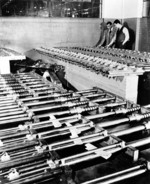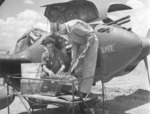20 mm M2 Hispano Aircraft Autocannon
| Country of Origin | United States |
| Type | Aircraft Autocannon |
| Caliber | 20.000 mm |
| Length | 2.360 m |
| Weight | 42.000 kg |
| Ammunition Weight | 0.13 kg |
| Rate of Fire | 600 rounds/min |
| Muzzle Velocity | 830 m/s |
Contributor: Alan Chanter
ww2dbaseThe 20mm M2 Hispano aircraft cannon was a development of the French Hispano-Suiza HS.404 built under license in the United States for the USAAC and US Navy. Originally designed by Marc Birkigt, the chief engineer of Hispano-Suiza, in 1933, as a replacement to the Swiss Oerlikon the new weapon employed the locking mechanism which had been patented in 1919 by the American machine-gun designer Carl Swebilius.In 1938, the French government requested an aircraft based version of the HS.404 to be installed on a wide range of pre-war French fighter plane designs, notably in installations that fired through the drive shaft of the Hispano-Suiza 12Y engine. Drum-fed in earlier versions the cannon's magazine could accommodate only 60 rounds which was something of a drawback. Later a belt-fed system was developed which then became standard on all World War II cannon armed aircraft.
In the build-up to the Second World War the United Kingdom, embarking on a programme to develop cannon-armed fighters, acquired a licence to build the HS.404. Its first use was in the 1940 Westland Whirlwind, and the Bristol Beaufighter nightfighter. A small number of Spitfire fighters were fitted with the 20mm cannon in the latter stages of the Battle of Britain but a tendency for the gun to jam during combat, frequently after only one shot, that the RAF Squadron soon demanded that they be replaced with the eight 0.303-in machine-gun armed version.
By 1941 the British Air Ministry had become concerned that production was becoming inadequate and so a manufacturing license was granted to the United States. The Americans planned a very large building program along with plentiful ammunition production, but the resultant weapons, designated M1, proved to be a disappointment and the British eventually gave up on the American system and set about improving their own model with a shorter barrel that could, with some loss of muzzle velocity, be incorporated into a fighter's slender wing.
Meanwhile, the Americans continued to progress with various redesigns of their own and eventually an improved M2 version, developed by International Harvester, was standardised for use on the Lockheed P-38 Lightning aircraft. The US Navy despite rating the 20mm cannon very highly and facing the need to deal with attacking bombers and Kamikaze aircraft fitted it to few aircraft. There was serious production problems with the American Hispano which gave it a reputation for unreliability. Despite this production would run well into six figures although the American Hispano never managed to achieve an acceptable reliability standard throughout the war.
The advantages of the 20mm Hispano M2, nevertheless, could not be entirely ignored. It was carried by the P-38 along with four Browning 0.50-in machine guns; by the B-29 Superfortress (which had one in the tail position); and by nightfighters such as the P-61 Black Widow which needed a maximum firepower to convert a short firing opportunity into a kill. It was similarly found useful when mounted in the Grumman F6F-5N where the extra firepower was much appreciated for ground strafing.
After the war the US Navy quickly changed over to the 20mm cannon in its improved, faster-firing and more reliable M3 form, but the USAF stayed with the 0.50 Browning guns until after the Korean war. From the mid 1950s the USAF finally began replacing the old Brownings with 20mm cannons, initially with the M39 revolver and then with the M61 rotary - just as most of the rest of the world were switching over to 30mm.
Sources:
Wikipedia
Anthong G Williams, "Cannon or Machine Gun?" (History in the Air - Aeroplane, September 2004) ww2dbase
Last Major Revision: Apr 2015
Photographs
 |  |
Please consider supporting us on Patreon. Even $1 per month will go a long way! Thank you. Please help us spread the word: Stay updated with WW2DB: |
Visitor Submitted Comments
2. You know who says:
14 Jul 2015 05:21:02 AM
The Americans sure made the best weapons didn't they Alan?...also, why in the hell would you call the Brownings old?...insinuating that it was not an effective weapon?...is that what you are saying?...the 50cal is still in widespread use, especially mounted at a tank commanders hatch, maybe even mounted on the worlds third best tank the Challenger behind the Abrahms and Leopard 2, hell the 50cal round has found new life as a sniper round as you may or may not know, but I am sure you do because you are very knowledgable about US superiority in weapons designers and makers, but I think as much as I know you love American equipment, you know that...
14 Jul 2015 05:21:02 AM
The Americans sure made the best weapons didn't they Alan?...also, why in the hell would you call the Brownings old?...insinuating that it was not an effective weapon?...is that what you are saying?...the 50cal is still in widespread use, especially mounted at a tank commanders hatch, maybe even mounted on the worlds third best tank the Challenger behind the Abrahms and Leopard 2, hell the 50cal round has found new life as a sniper round as you may or may not know, but I am sure you do because you are very knowledgable about US superiority in weapons designers and makers, but I think as much as I know you love American equipment, you know that...
3.  Alan Chanter says:
Alan Chanter says:
11 Aug 2018 05:58:35 AM
The single 20mm cannon initially carried in the tail turret of the B-29 Superfortress were little used operationally as they were never too effective, due to different trajectories, when combined with the turret’s twin .50 Browning machine guns. The cannons were permanently removed after the low-level Tokyo raids in March 1945.
11 Aug 2018 05:58:35 AM
The single 20mm cannon initially carried in the tail turret of the B-29 Superfortress were little used operationally as they were never too effective, due to different trajectories, when combined with the turret’s twin .50 Browning machine guns. The cannons were permanently removed after the low-level Tokyo raids in March 1945.
4. W-2 Div says:
7 Feb 2020 04:45:49 PM
Had a bit of experience with the GM-built 20s (Buick/Oldsmobile, 1944) in the 90s. They were uniformly horrible. On one occasion we were conducting a live-fire with a newly reconditioned weapon out of NSWC Crane, I was Mount Captain. When my Gunner had ripped off 1/2 of a can I began yelling "go go go"; he stopped to see what was wrong...and that was that. Normal mode was bang-bang-click, negligible g-loading as we were shipboard. When my Dad came to visit in '94 he inquired specifically about the 20s; "piece of junk, aren't they?" I most heartily agreed. Dad had been an Armorer with the ill-fated 33rd Pursuit (Provisional) in Darwin, subsequently with the 7th of the 49th Pursuit Group. He knew a bit regarding Brownings and GM 20s...
7 Feb 2020 04:45:49 PM
Had a bit of experience with the GM-built 20s (Buick/Oldsmobile, 1944) in the 90s. They were uniformly horrible. On one occasion we were conducting a live-fire with a newly reconditioned weapon out of NSWC Crane, I was Mount Captain. When my Gunner had ripped off 1/2 of a can I began yelling "go go go"; he stopped to see what was wrong...and that was that. Normal mode was bang-bang-click, negligible g-loading as we were shipboard. When my Dad came to visit in '94 he inquired specifically about the 20s; "piece of junk, aren't they?" I most heartily agreed. Dad had been an Armorer with the ill-fated 33rd Pursuit (Provisional) in Darwin, subsequently with the 7th of the 49th Pursuit Group. He knew a bit regarding Brownings and GM 20s...
5. Anonymous says:
24 Apr 2023 07:23:10 AM
I just wanted to ask how many of the 20mm M2 Hispano Aircraft Autocannon guns were used in the battle of britain?-if anybody knows
24 Apr 2023 07:23:10 AM
I just wanted to ask how many of the 20mm M2 Hispano Aircraft Autocannon guns were used in the battle of britain?-if anybody knows
All visitor submitted comments are opinions of those making the submissions and do not reflect views of WW2DB.
Search WW2DB

News
- » Wreck of Teruzuki Found (27 Jul 2025)
- » USS Orlean's Bow Found (22 Jul 2025)
- » The Emperor of Japan Planned to Honor WW2-era Japanese POWs in Mongolia (4 Jul 2025)
- » US State Lawmaker John Winter Caught Using Racial Slur "Jap" and Apologized (11 Jun 2025)
- » US Government Plans to Purge WW2 Information (17 Mar 2025)
- » See all news
20 mm M2 Hispano Aircraft Autocannon Photo Gallery
 |
Current Site Statistics
- » 1,182 biographies
- » 337 events
- » 45,132 timeline entries
- » 1,249 ships
- » 350 aircraft models
- » 207 vehicle models
- » 376 weapon models
- » 123 historical documents
- » 261 facilities
- » 470 book reviews
- » 28,430 photos
- » 365 maps
Famous WW2 Quote
"An appeaser is one who feeds a crocodile, hoping it will eat him last."Winston Churchill
Support Us
Please consider supporting us on Patreon. Even $1 a month will go a long way. Thank you!
Or, please support us by purchasing some WW2DB merchandise at TeeSpring, Thank you!
13 Apr 2015 07:39:45 AM
so mant weapons i dont know about